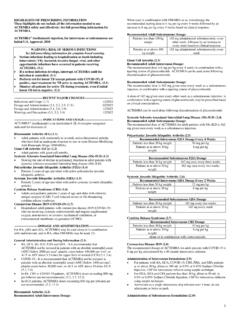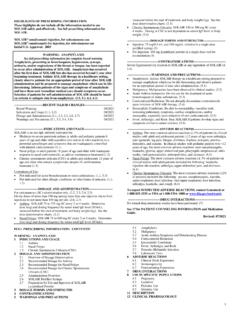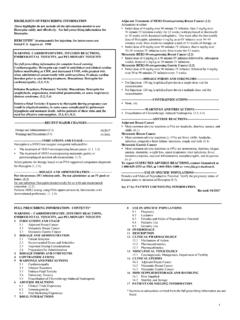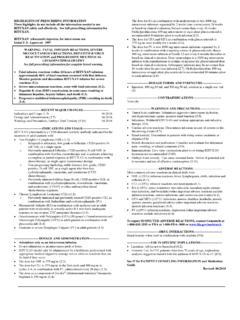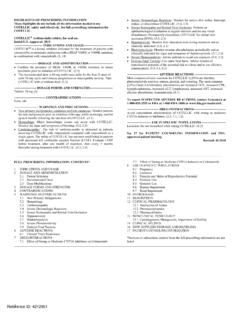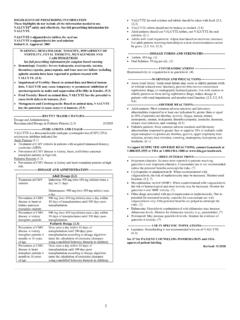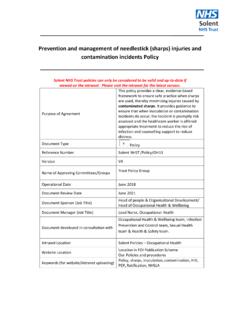Transcription of OCREVUS Prescribing Information - Genentech
1 HIGHLIGHTS OF Prescribing INFORMATIONT hese highlights do not include all the Information needed to use OCREVUS safely and effectively. See full Prescribing Information for (ocrelizumab) injection, for intravenous useInitial Approval: 2017---------------------------RECENT MAJOR CHANGES---------------------------Dosage and Administration ( , ) 12/2020 Warnings and Precautions( , )11/2020---------------------------INDIC ATIONS AND USAGE---------------------------- OCREVUS is aCD20-directed cytolytic antibody indicated for the treatment of: Relapsing forms of multiple sclerosis (MS),to include clinically isolated syndrome, relapsing-remitting disease, and active secondary progressive disease, in adults(1) Primary progressive MS, in adults(1)-----------------------DOSAGE AND ADMINISTRATION----------------------- hepatitis B virusand quantitative serum immunoglobulin screening are required before the first dose ( ) Pre-medicate with methylprednisolone (or an equivalent corticosteroid) and an antihistamine( , diphenhydramine)prior to each infusion ( ) AdministerOCREVUS by intravenous infusionoStart dose.
2 300 mg intravenous infusion, followed two weeks later by a second 300 mg intravenous infusion ( )oSubsequent doses: 600 mg intravenous infusionevery 6 months( ) Must be diluted prior to administration ( , ) Monitor patients closely during and for at least one hour after infusion ( , )---------------------DOSAGE FORMS AND STRENGTHS---------------------- Injection: 300 mg/10 mL (30 mg/mL) in a single-dose vial (3)------------------------------CONTRAI NDICATIONS------------------------------ Active hepatitis B virus infection (4) History of life-threatening infusion reaction to OCREVUS (4)-----------------------WARNING S AND PRECAUTIONS----------------------- Infusion Reactions: Management recommendations for infusion reactions depend on the type and severity of the reaction.
3 Permanently discontinue OCREVUS if a life-threatening or disabling infusion reaction occurs( , ) Infections: Delay OCREVUS administration in patients with an active infection until the infection is resolved. Vaccination with live-attenuated or live vaccines is not recommendedduring treatment with OCREVUS and after discontinuation, until B-cell repletion( ) Reduction in Immunoglobulins: Monitor the level of immunoglobulins at the beginningof treatment. Monitorduring and after discontinuation of treatment with OCREVUS , until B-cell repletion, and especially when recurrent serious infections are suspected. Consider discontinuing OCREVUS in patients withserious opportunisticor recurrentserious infections, and if prolonged hypogammaglobulinemia requires treatment with intravenous immunoglobulins ( , ) Malignancies: An increased risk of malignancy, including breast cancer, may existwith OCREVUS ( )------------------------------ADVERSE REACTIONS------------------------------T he most common adverse reactionswere: RMS (incidence 10% and > REBIF): upper respiratory tract infections and infusion reactions( ) PPMS (incidence 10% and > placebo).
4 Upper respiratory tract infections, infusion reactions, skin infections, and lower respiratory tract infections( )To report SUSPECTED ADVERSE REACTIONS, contact Genentechat 1-888-835-2555or FDA at 1-800-FDA-1088 IN SPECIFIC POPULATIONS----------------------- Pregnancy: Based on animal data, may cause fetal harm ( )See 17 for PATIENT COUNSELING Information and Medication : 03/2021_____FULL Prescribing Information : CONTENTS*1 INDICATIONS AND USAGE2 DOSAGE AND Assessments Prior to First Dose of Preparation Before Every RecommendedDosage and Dose Delayed or Missed Dose ModificationsBecause of Infusion Preparation and Storage of the Dilute Solution for Infusion3 DOSAGE FORMS AND STRENGTHS4 CONTRAINDICATIONS5 WARNINGS AND InfusionReactions Reduction in Malignancies6 ADVERSE Clinical Trials Postmarketing Experience7 DRUG Immunosuppressive or Immune-Modulating Vaccinations8 USE IN SPECIFIC Females and Males of Reproductive Pediatric Geriatric Use11 DESCRIPTION12 CLINICAL Mechanism of
5 Pharmacokinetics13 NONCLINICAL Carcinogenesis, Mutagenesis, Impairment of Fertility14 CLINICAL Relapsing Forms of Multiple Sclerosis(RMS) Primary Progressive Multiple Sclerosis(PPMS) Safety Study of 2-Hour Infusions16 HOW SUPPLIED/STORAGE AND HANDLING17 PATIENT COUNSELING Information *Sections or subsections omitted from the full Prescribing Information are not listed_____FULL Prescribing INFORMATION1 INDICATIONS AND USAGEOCREVUS is indicated for the treatment of: Relapsing forms of multiple sclerosis (MS), to include clinically isolated syndrome, relapsing-remitting disease, and active secondary progressive disease, in adults Primary progressive MS, in adults2 DOSAGE AND Assessments Prior to First Dose of OCREVUS hepatitis B virus ScreeningPrior to initiating OCREVUS , perform hepatitis B virus (HBV) screening.
6 OCREVUS is contraindicated in patients with active HBV confirmed by positive results for HBsAg and anti-HBV tests. For patients who are negative for surface antigen [HBsAg] and positive for HB core antibody [HBcAb+] or are carriers of HBV [HBsAg+], consult liver disease experts before starting and during treatment [see Warnings and Precautions ( )].Serum ImmunoglobulinsPrior to initiating OCREVUS , perform testing for quantitative serum immunoglobulins [see Warnings and Precautions ( )]. For patients with low serum immunoglobulins, consult immunology experts before initiating treatment with vaccination with live-attenuated or live vaccines is not recommended during treatment and after discontinuation until B-cell repletion, administer all immunizations according to immunization guidelines at least 4 weeks prior to initiation of OCREVUS for live or live-attenuated vaccines and, whenever possible, at least 2 weeks prior to initiation of OCREVUS for non-live vaccines[see Warnings and Precautions ( ) and Clinical Pharmacology ( )].
7 Preparation Before Every InfusionInfection AssessmentPrior to every infusion of OCREVUS , determine whether there is an active infection. In case of active infection, delay infusion of OCREVUS until the infection resolves[see Warnings and Precautions ( )].Recommended PremedicationPre-medicate with 100 mg of methylprednisolone (or an equivalent corticosteroid) administered intravenously approximately 30 minutes prior to each OCREVUS infusion to reduce the frequency and severity of infusion reactions [see Warnings and Precautions ( )]. Pre-medicate with an antihistamine ( , diphenhydramine) approximately 30-60 minutes prior to each OCREVUS infusion to further reduce the frequency and severity of infusion reactions.
8 The addition of an antipyretic ( , acetaminophen) may also be Recommended Dosage and Dose Administration Administer OCREVUS under the close supervision of an experienced healthcare professional with access to appropriate medical support to manage severe reactions such as serious infusion reactions. Initialdose: 300 mg intravenous infusion, followedtwo weeks later by a second 300 mg intravenous infusion. Subsequentdoses: single 600 mg intravenousinfusion every 6 months. Observe the patient for at least one hour after the completion of the infusion [see Warnings and Precautions ( )]. Table 1 Recommended Dose, Infusion Rate, and Infusion Durationfor RMS and PPMSA mount and Volume1 Infusion Rateand Duration3 InitialDose(two infusions)Infusion 1300 mgin 250 mL Start at 30 mL per hour Increase by 30 mL per hour every 30 minutes Maximum: 180 mLper hour Duration: hours or longerInfusion 2(2 weeks later)300 mgin 250 mLSubsequent Doses(one infusion)every 6 months)2 Option 1 Infusion of approximately hours duration3600 mgin 500 mL Start at 40 mL per hour Increase by 40 mL per hour every 30 minutes Maximum: 200 mL per hour Duration.
9 Hours or longerOROption 2 (If no prior serious infusion reaction with any previous OCREVUS infusion)4 Infusion of approximately 2 hours duration3600 mgin 500 mL Start at100 mL per hourfor the first 15 minutes Increase to 200 mL per hourfor the next 15 minutes Increase to 250 mL per hour for the next 30 minutes Increase to 300 mL per hour for the remaining 60 minutesDuration: 2 hours or longer1 Solutions of OCREVUS for intravenous infusion are prepared by dilution of the drug product into an infusion bag containing Sodium ChlorideInjection, to a final drug concentration ofapproximately the first Subsequent Dose6 months after Infusion 1 of the Initial time may take longer if the infusion is interrupted or slowed[see Dosage and Administration ( )].
10 4[see Adverse Reactions ( ) and Clinical Studies ( )]. Delayed or Missed Doses If a planned infusion of OCREVUS is missed, administerOCREVUSas soon as possible; do not wait until the next scheduled dose. Reset the dose schedule to administer the next sequential dose 6 months after the missed dose is administered. Doses of OCREVUS must be separated by at least 5 months [see Dosage and Administration ( )]. Dose ModificationsBecause ofInfusion ReactionsDose modifications in response to infusion reactions depends on the severity. Life-threatening Infusion ReactionsImmediately stop and permanently discontinue OCREVUS if there are signs of a life-threatening or disabling infusion reaction[see Warnings and Precautions ( )].
